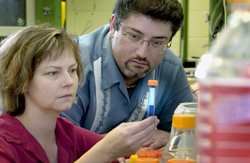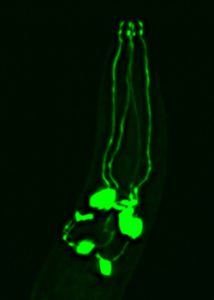Scientists Demonstrate Protein’s Therapeutic Potential for Parkinson’s
By Chris Bryant

University of Alabama researchers have demonstrated that a specific protein protects against the loss of the brain neurons whose demise leads to Parkinson’s disease, a central nervous system disorder estimated to affect more than 1 million Americans.
The UA laboratory’s findings, obtained from research on an animal model system, published in an April 2005 issue of The Journal of Neuroscience, where it was one of only four articles selected for the publication’s “This Week in the Journal” highlight section.
“Parkinson’s disease is caused by the loss of dopamine producing neurons in the brain as people age,” said Dr. Guy Caldwell, assistant professor of biological sciences at UA and a co-author of the journal paper. “Here, we have identified a naturally protective factor that is already there in our brains, and we’ve shown it has the capacity to protect those same dopamine neurons from dying during the course of aging. The trick, in the future, is how do we enhance that effect?”

The paper, whose co-authors include Dr. Kim Caldwell, also an assistant professor of biological sciences; Songsong Cao, a doctoral student who works with the Caldwells, and Christopher Gelwix, a former UA undergraduate and graduate student, centers around a protein called torsinA and its ability to protect dopamine neurons against the stresses that cause them to die.
“What our paper shows is that torsins have the capacity to function in a neuroprotective manner – thus, providing an insight into their native role in dopamine neurons, while simultaneously indicating their potential therapeutic value for Parkinson’s disease,” Guy Caldwell said.
While torsinA appears to exhibit a protective capacity in neurons, specific defects in torsinA can lead to another human movement disorder called early-onset torsion dystonia. Thus, the findings also further define a functional role for torsins in neurons, revealing key information for research into dystonia as well.
Parkinson’s disease is characterized by rigid and tremoring limbs, difficulty in movement, and impaired reflexes.
Songsong Cao, the doctoral student who is the lead author on the paper, was recently recognized with UA’s Excellence in Research by a Doctoral Student award, given annually to UA’s top doctoral student researcher.
The Caldwell lab has drawn research support from agencies including the Michael J. Fox Foundation, National Parkinson Foundation, Parkinson’s Disease Foundation, The Bachmann-Strauss Dystonia & Parkinson’s Foundation, The March of Dimes, National Institutes of Health, Dystonia Medical Research Foundation, National Science Foundation and the Howard Hughes Medical Institute.
Further Reading